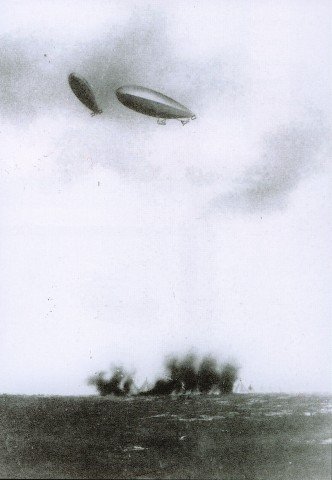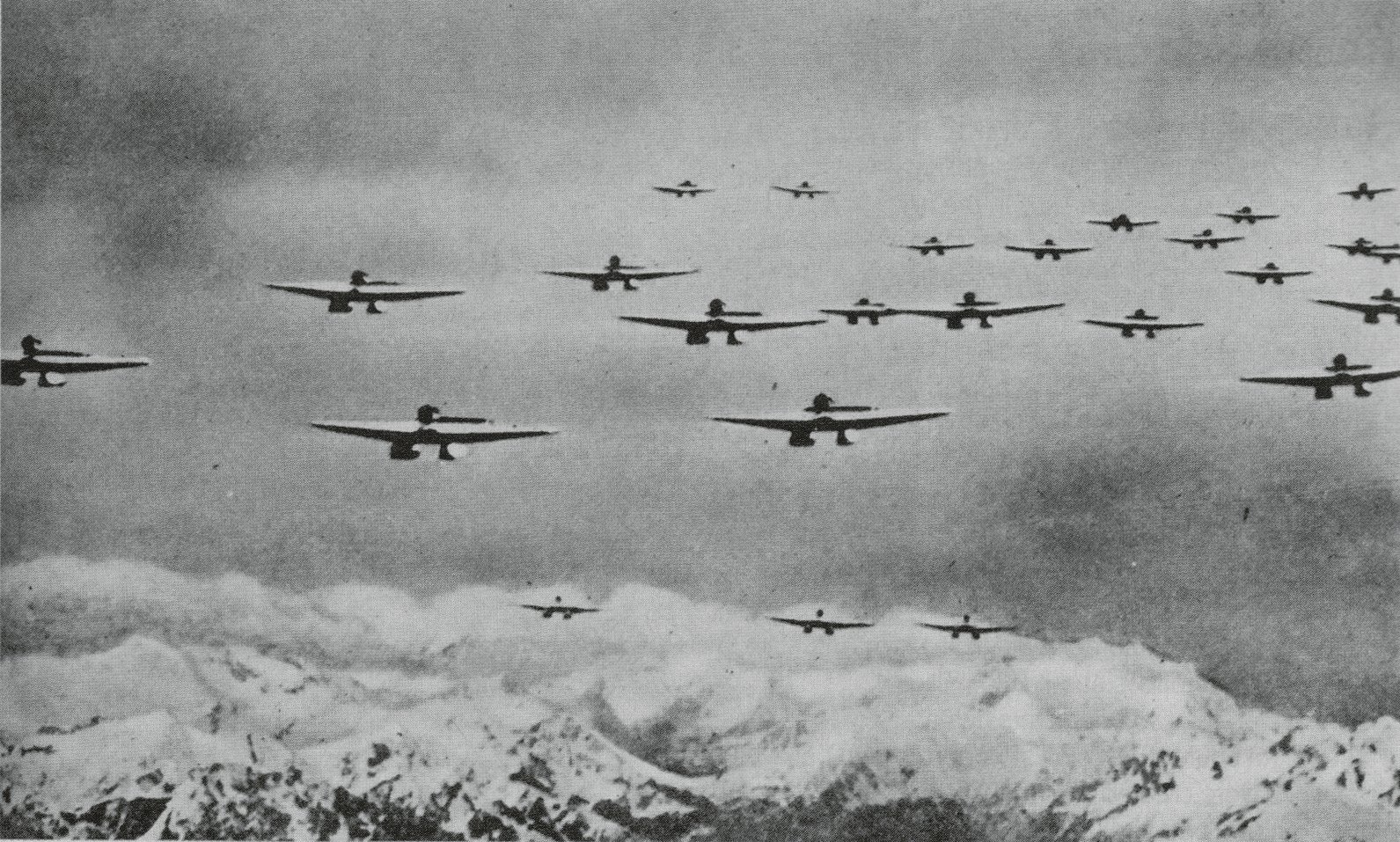
The aforementioned Mike Dash sent me the above photograph, presumably a fake, wondering if I’d seen it before and if I knew its provenance. I have not, but I agree it’s a fake. It can be found in a few places on the web, for example here and here.
It purportedly shows two Italian airships bombing a Turkish encampment in the Italo-Turkish War in 1912, one of the very first air attacks ever made. The airships do look like the airships used by Italy in Libya, namely the three P-types, highly streamlined semi-rigid dirigibles built in 1910-1 — note the control surfaces at the rear. But they don’t look real; at the least they have been heavily retouched. The gondola of the airship on the right doesn’t look like it’s in the right place, though that could be perspective. Also, from the (real) photos I’ve seen, the Ps didn’t have shiny-silver envelopes, but had a darkened and banded appearance. And there’s just too much going on. The airships are swooping, the bombs are exploding, and the cameraman was in the right place at the right time to capture it. I don’t buy it. I suspect it was probably faked for Turkish consumption to show how the Italians were using inhumane new methods of warfare (the supposed photographer would have to be Turkish to be plausibly near a Turkish army encampment). That it seems to first appeared on a Turkish website may support this. But if anyone knows anything definite, please comment.
Here are a couple of other images I came across while looking for other photos of the Italian airships at war. They’re from Willis J. Abbot, Aircraft and Submarines: The Story of the Invention, Development, and Present-Day Uses of War’s Newest Weapons (New York and London: G. P. Putnam’s Sons, 1918), which has a lot of great illustrations.

The caption for this one reads:
German Air Raiders over England.
In the foreground three British planes are advancing to the attack.
No date or location (other than England) given, but with that many aeroplanes in daylight they must be Gothas in 1917. Those are some very dubious-looking aeroplanes there. They look like they’ve been drawn on. Once again there’s too much going on — I don’t think three British fighters ever intercepted a Gotha raid like that. And there’s something odd going on with the area around the tree. It’s possible that we’re not supposed to believe that it’s an actual photograph of a Gotha raid; maybe a contemporary viewer would have understood that it’s an artist’s depiction. The attached image credit says ‘Photo by International Film Service‘, which on the one hand suggests it was presented as a photo; but on the other, International Film Service was an animation company run by Randolph Hearst. That would seem to be the clincher, then.

I’m inclined to lend this last one a bit more credence. The caption:
A Burning Balloon,
Photographed from a Parachute by the Escaping Balloonist.
If it’s fake, at least it’s more skillfully done — the smoke plume looks quite realistic. Balloon observers did have parachutes for use in emergencies (at least in British service — unlike aeroplane crews) and they did have cameras with them, for aerial photography. They would have been valuable, so maybe escaping observers did try to take them with them when they jumped out. But I imagine the cameras were fairly bulky affairs: even if the balloonist did have the presence of mind to take a photo of his burning balloon is it likely he could get such a clear shot from his swaying parachute? And he’s a long way from his balloon, for that matter, although perhaps that’s down to the wind. I’d have to conclude this is a fake too.
Not that there’s anything wrong with that, as such: some of the great Frank Hurley’s most effective war photos were composites, which is pretty close to fake. But present them as authentic is to commit genre crime.
![]() This work is licensed under a Creative Commons Attribution-NonCommercial-NoDerivatives 4.0 International License.
Permissions beyond the scope of this license may be available at http://airminded.org/copyright/.
This work is licensed under a Creative Commons Attribution-NonCommercial-NoDerivatives 4.0 International License.
Permissions beyond the scope of this license may be available at http://airminded.org/copyright/.




This is sort of unrelated, but has been bugging me for some time now. Given that aerial bombing was practiced pretty widely in the 1910s, why was Guernica such a big deal?
There are a few aspects to this. One is that between 1918 and 1937 (well, 1936 — Madrid) bombing of civilians didn’t take place (well, unless your skin wasn’t white), so there was some hope that the precedent would lapse. Guernica seemed to show that to the contrary, bombing of civilians was becoming normalised and accepted as a part of modern war.
The other thing was the big increase in the power of air raids (improving technology, greater aircraft numbers). Guernica received about as many tons of bombs in less than 3 hours as Gothas dropped on Britain in all of 1917, and (it was thought) killed more than twice as many people. So air raids were worse than ever. And since the bomber will always get through …
Having said that, I do think the short-term impact of Guernica has been overrated somewhat, though it did stick in the public mind.
A good read on this subject is Ian Patterson, Guernica and Total War (London: Profile Books, 2007).
Pingback: Airminded · Am I fake or not? — III
I also think it’s a fake: photography was a complex issue back in early years of past centuries, and the cameras weren’t ready to shoot at any time. In addition, not many air attacks were really carried on in that war. It was the first time ever that air vehicles were ever used in (or near) combat.
Yes, I think it’s just too good to be true. Which is the case for so many of these early photographs.
Good luck with your blog, it looks very interesting — I just wish I could read Italian!
Thank you very much! Unfortunately, I don’t feel comfortable enough to write my blog in English. However I’ll keep on following your researches.
No reason why you should write in English! And I always have Google Translate…
Pingback: Am I fake or not? — IV | Airminded